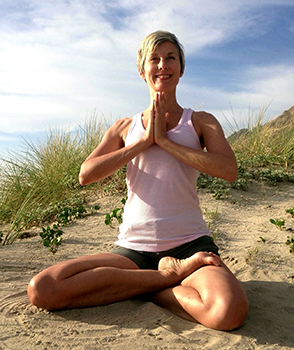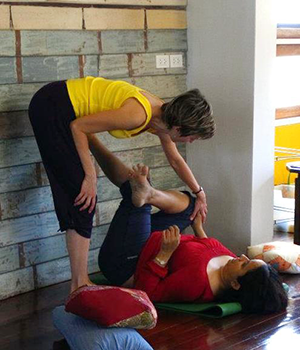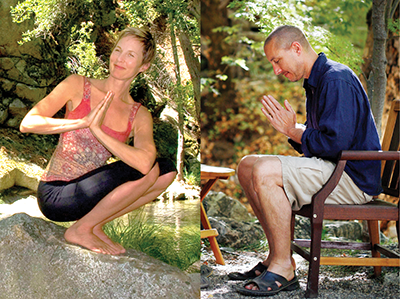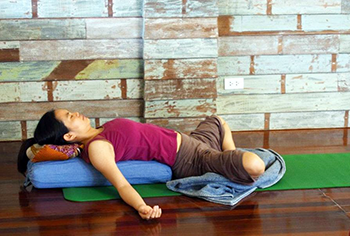Our bodies teach us in a very concrete way about the reality of impermanence and interdependence. They teach us about love, compassion, and intimacy. —Samantha Ostergaard
The body understands a lot that extends beyond our thinking mind and is central to establishing balance in our lives. In this interview, lifelong yoga and Zen practitioner Samantha Ostergaard shares some of her insights into the wisdom of the body.
Interview by Amity Bacon, Writer and Zen Practitioner at San Francisco Zen Center

Amity: How are yoga and Zen complementary spiritual practices?
Samantha: Yoga as we practice it in the U.S. is mostly the physical poses or asanas. This leaves out the rest of the yoga tradition that is about meditation practices and how to live our spiritual practice in every aspect of our lives. So this part that is missing from the yoga tradition is exactly what Zen, especially the way we practice it at Zen Center, is so good at. At the Zen Center, this is a living tradition — it’s not something we sit around talking about, we actually do it, day after day, year after year.
Robert [Do-on Robert Thomas] and I spent years at Tassajara [Zen Mountain Center], doing retreats, and generally living in a way that taught us to bring our meditative awareness into every moment of our activity. The insights we gained while living at Tassajara, as we tried–and often failed!–to practice this are a big part of what we offer in our retreats. We feel it is our responsibility to be a resource for people who aren’t able to take a year or two off to go live in a monastery and figure it out that way.
What we are missing in the Zen tradition is that we need to move our bodies in more ways than just sitting cross-legged for meditation. We need to move and stretch and turn upside down, because our lives are so sedentary, and when we don’t move enough, our bodies don’t function well. So the yoga provides this part that is lacking in Zen. The yoga also helps get the body ready to sit on cushions in a cross-legged position. In our retreats, the yoga sessions are always followed by a period of meditation so that we can enjoy these benefits of yoga during the meditation.
 A lot of people are afraid of meditation because they have physical discomfort. The pain that many people feel when they sit in meditation is often totally unnecessary. I also make sure that the yoga sessions take care of this as much as possible, by opening up parts of the body and releasing tension so that people can have a positive meditation experience.
A lot of people are afraid of meditation because they have physical discomfort. The pain that many people feel when they sit in meditation is often totally unnecessary. I also make sure that the yoga sessions take care of this as much as possible, by opening up parts of the body and releasing tension so that people can have a positive meditation experience.
Many people have told me during our retreats that they meditated without pain for the first time. One person told me that he had been practicing Vipassana meditation for 30 years, and this was the first time he had ever meditated without pain. At a recent retreat in Santa Fe, a lady told me before the first practice session that she was very afraid of meditation for both mental and physical reasons. Then at the end of the session, which included yoga followed by meditation, she told me that she had had the most wonderful experience of meditation, beyond what she could have imagined was possible. A door was opened for her. This is the kind of experience many people have in our retreats.
Getting back to your question, the yoga is a big help with the effects of stress—poor breathing patterns, patterns of tension and holding in different parts of the body—that can have a big impact on our wellbeing and on the quality of our meditation sessions. I always teach some therapeutic yoga to address these effects of stress that pretty much everyone is dealing with.
I always give some restorative postures as well, so that people can really rest and restore their vital energy, which get so depleted from trying to keep up with the demands of their busy lives. All of these ways of taking care of the body are missing from the Zen tradition, that pretty much ignores many aspects of the body. Yoga really makes up for this deficit.
Amity: What opens up to us when we actually experience our bodies more intimately through yoga?
Samantha: Our bodies are the foundation for all spiritual practice. We can’t do it with just our minds. We start by paying attention to the experience of the body as a way to stabilize and calm the mind. This can mean simply noticing the sensation of the breath, which is a good point of focus for the mind, both in yoga practice and in meditation.
Then, we can start to cultivate the ability to stay present and aware of the sensations of the body more of the time, and this can give us so much information about what is actually going on inside of us, more than if we just pay attention to our thinking minds. It is a way to begin to know ourselves in a deeper way.
In Buddhism we have a healthy disrespect for the thinking mind that makes up stories all day long about our experience. These stories and ideas distort our experience and cause us to respond in ways that cause suffering for ourselves and those around us. In our retreats, I introduce ways to bring this insight into the yoga practice, so we can begin to work with the mind and body while we move. This is good practice for taking the mind of meditation into our everyday activity.
Our bodies don’t lie. Our thoughts lie to us all the time, but our bodies tell the truth. They tell us all about how we really feel, what we really want, and what we really need. Our bodies teach us in a very concrete way about the reality of impermanence and interdependence. They teach us about love, compassion, and intimacy.
If we learn to listen to our bodies, then there is so much potential for transformation in our lives. Just by beginning to listen to our bodies, just through this very simple, humble, quiet activity, we can access the truth of who we really are in our innermost self. We can begin to live our lives according to the truth of how we really want to act in relation to ourselves and to others. We begin to learn how to take good care of ourselves and those around us, to be in harmony with ourselves and with others.
______________________________________________________________________
 Samantha Ostergaard and Do-on Robert Thomas have taught Zen Mind, Yoga Body retreats together since 2007, at San Francisco Zen Center and worldwide. Read more about the Manifesting the Wisdom of the Body series of Zen Mind, Yoga Body retreats on sfzc.org.
Samantha Ostergaard and Do-on Robert Thomas have taught Zen Mind, Yoga Body retreats together since 2007, at San Francisco Zen Center and worldwide. Read more about the Manifesting the Wisdom of the Body series of Zen Mind, Yoga Body retreats on sfzc.org.












